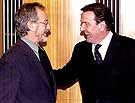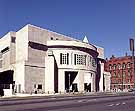
|
|
|

|

|

|

|
|
Click on an image to see a larger, more detailed picture.
|
|
|
|
|
| EPILOGUE: The Aftermath |

|
pg. 686 |

|
|
|
|
| |
 In 1999 German Chancellor Gerhard Schroeder and U.S. film director Steven Spielberg discuss incorporating elements of Spielberg's "Shoah Foundation," which videotapes survivor testimonies, into the planned Holocaust memorial in Berlin.
In 1999 German Chancellor Gerhard Schroeder and U.S. film director Steven Spielberg discuss incorporating elements of Spielberg's "Shoah Foundation," which videotapes survivor testimonies, into the planned Holocaust memorial in Berlin.
Photo: Reuters/Reinhard Krause/Archive Photos
|
|
In addition, the Shoah Foundation has developed CD-ROM material for use in school classrooms and films, including an Academy Award-winning documentary, The Last Days (1998), which featured five Hungarian Jews who were targeted during the Final Solution's last phase in 1944. The documentary confirms Charlotte Delbo's judgment when she said: "We were clinging to a hope made up of so many fragile pieces that not one of them could have resisted close scrutiny had we kept a modicum of common sense. To have lost that common sense, and persisted in the madness of hope, saved some of us. Their number is so small that it proves nothing."
|
 The United States Holocaust Memorial Museum in Washington memorializes the murdered millions. Visitors feel the impact of the Holocaust through photographs, words, artifacts, artwork, film, and videotaped testimony.
The United States Holocaust Memorial Museum in Washington memorializes the murdered millions. Visitors feel the impact of the Holocaust through photographs, words, artifacts, artwork, film, and videotaped testimony.
Photo: Ullstein Bilderdienst
|
|
In addition to the Shoah Foundation, repositories for survivor interviews can be found in several other places, including Yad Vashem, the Israeli Holocaust memorial and research center in Jerusalem; the Fortunoff Video Archive for Holocaust Testimonies at Yale University; and the United States Holocaust Memorial Museum in Washington, D.C. The USHMM opened in April 1993. On April 8, 1999, two weeks short of its sixth anniversary, the visitor total reached 12 million, including 8.6 million non-Jews. Typically, the survivors speak about their lives before, during, and after the Holocaust. After Auschwitz, the human mind wants to make sense of the emotional turmoil provoked by Holocaust testimonies. The yearning runs deep for justice to prevail, wholeness to be restored, moral expectations to be vindicated, and the human spirit to be triumphant. But the testimonies show that what Holocaust survivor Ida Fink called "the ruins of memory"--they include starvation, beatings, devastating illness, gassings, the smoke and smell of burning flesh, cannibalism--leave such optimism in scarce supply. One survivor whose testimony can be found in Yale's Fortunoff Archive remembers seeing the sun at Auschwitz. "I saw the sun come up," she says, "because we had to get up at four in the morning. But it was never beautiful to me. I never saw it shine. It was just the beginning of a horrible day." Grieving both for her losses at Auschwitz and for how little her post-Holocaust hope--that the Holocaust's history would teach people to be more humane--has been fulfilled, another woman says of her survival, "I don't know if it was worth it."
|
|

|

|

|

|
 Winter 1995: Bayer, a subsidiary of I.G. Farben, apologizes for the pain, suffering, and exploitation the company perpetrated.
Winter 1995: Bayer, a subsidiary of I.G. Farben, apologizes for the pain, suffering, and exploitation the company perpetrated.
|
 1996: A commercial developer based near Oswiecim (Auschwitz), Poland, shelves plans to build a mini-mall across from the Auschwitz Museum after being stung by worldwide condemnation of his scheme.
1996: A commercial developer based near Oswiecim (Auschwitz), Poland, shelves plans to build a mini-mall across from the Auschwitz Museum after being stung by worldwide condemnation of his scheme.
|
 1996: Argentine researchers discover the first hard evidence linking former Argentina President Juan Peron and his wife, Eva, to the secret entry of at least dozens of fugitive Nazis into Argentina following the war. Top Peron aides engaged Argentina-born SS captain Horst Fuldner to coordinate the program.
1996: Argentine researchers discover the first hard evidence linking former Argentina President Juan Peron and his wife, Eva, to the secret entry of at least dozens of fugitive Nazis into Argentina following the war. Top Peron aides engaged Argentina-born SS captain Horst Fuldner to coordinate the program.
|
 April 1996: American book publisher St. Martin's cancels publication of Goebbels, a biography by revisionist British historian David Irving. The book argues that Hitler neither intended to commit the Holocaust nor had knowledge of it.
April 1996: American book publisher St. Martin's cancels publication of Goebbels, a biography by revisionist British historian David Irving. The book argues that Hitler neither intended to commit the Holocaust nor had knowledge of it.
|
 May 1996: Swiss bankers and the World Jewish Congress establish an investigative panel to look into probable Swiss misappropriation of Jewish funds during and after World War II. It also investigates wartime Switzerland's turning away of approximately 30,000 Jewish refugees from its borders; See September 1996.
May 1996: Swiss bankers and the World Jewish Congress establish an investigative panel to look into probable Swiss misappropriation of Jewish funds during and after World War II. It also investigates wartime Switzerland's turning away of approximately 30,000 Jewish refugees from its borders; See September 1996.
|
|
|
|
|
| EPILOGUE: The Aftermath |

|
pg. 686 |

|
|
The Holocaust Chronicle
© 2009 Publications International, Ltd.
|
|
